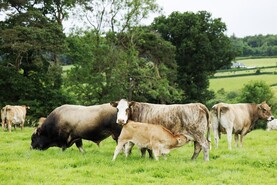Grazing forage crops
It has been a tough start to the winter for grazing kale crops over the past few weeks. Some farmers grazing forage crops are still reporting good utilisation rates where ground conditions are good.
Take note of how fast you are proceeding through the crop. It needs to be finished being grazed by mid-March 2024 (before flowering), so increase the stocking rate if you won’t hit this target.
Don’t forget to feed a fibre source (baled silage or straw) when grazing kale and make sure animals receive adequate minerals, as kale is deficient in trace elements. Many will bolus animals before starting to graze kale.
The question often arises as to whether meal needs to be fed along with the forage crop. In my experience it doesn’t, and it sort of defeats the purpose of outwintering if you have to go in with supplementary feed.
If there is frost or snow on the crop make sure to not move the fence until the crop has thawed in the afternoon. Under cross compliance animals need access to a dry lie back area off the kale.
Be careful where a tractor is going in and out of a field with bales, as if the soil becomes liquefiable it could attract a penalty during a cross compliance inspection. Cattle also need access to a dry area for lying.
Some farmers that were having problems with fences and animals knocking posts over have changed to posts that carry electric current to the ground and are finding these are working better.
Make sure there is a good current in the fence, maybe switch off other areas to leave more shock going to the brassica crop.
First Calver Nutrition and Health
Pay attention to first calving heifers and their body condition score in the shed. This is especially important for autumn calving heifers sucking calves. Heifers can lose condition very quickly, and this will result in delayed resumption of cycling and poor conception rates.
If silage quality is poor, first calved heifers should be getting 2-3kg/day of a good quality ration, high in energy. If you can separate these heifers out into a pen on their own, it will make meal feeding easier and prevent any bullying issues.
Make sure you are on top of worm and fluke control with this group, as any stress or burden will result in body condition loss. It’s especially critical where you are calving at 2 years old.
SCEP Tags
Genomic tags for genotyping under the SCEP must be submitted by Thursday 30 November. The scheme requires you to genotype 70% of the reference number of suckler cows in each year of the SCEP.
If less than 90% of the required number of samples are not returned in year one, then there will be no payment for that action. Genotyping is worth 20% of the overall payment. A 10% penalty will also be applied to the overall payment.
Where animals that were selected for genotyping have sold or died, you must order replacement tags to get you to the required 70% genotyped.
You can order these tags/hair cards by contacting ICBF on 023-8832883 but this needs to happen quickly to get samples back by 30 November.






 This is a subscriber-only article
This is a subscriber-only article










SHARING OPTIONS: